Excalibur




With our armed forces discount you could get a discount of up to £500 for every £25,000 you spend on a new home! It is exclusively available to Armed forces personnel at many Taylor Wimpey developments.
(Maximum value £5,000*)
• On a £200,000 home you could get a £4,000 discount


• £200,000 divided by £25,000 = 8
• 8 x £500 discount = £4,000
• Property purchase price with discount = £196,000
Nestled in the beautiful village of Aiskew, Beaumont Gate offers a selection of contemporary 2, 3 and 4 bedroom new homes in a range of styles to suit all families. Join this welcoming community surrounded by North Yorkshire countryside, independent traders, boutique stores and a selection of restaurants, cafes and bars.

The Garden Rooms at Tennants is a must visit destination in the Yorkshire Dales. Situated on the edge of the charming market town of Leyburn, visitors can enjoy lunch in the elegant Bistro, a light bite in the Café, explore two floors of galleries filled with art and antiques, visit an exhibition or listen to a lecture, browse in the Gift Shop or attend one of Tennants Auctioneers’ renowned auctions.
This Summer don’t miss the fascinating new exhibition Swaledale: Hidden Histories, which is open from 19th July to 27th August. The exhibition will
present years of dedicated research into the history of Swaledale and its communities by genealogist Derek Wallace, revealing long forgotten stories of its inhabitants and tracing the lives of those who left the Dale.
For anyone interested in art and antiques, you can explore Tennants Auctioneers, Europe’s largest privately owned auctioneers, on a Behind the Scenes Tour. The tours, on 12th and 13th July, coincide with Tennants’ Summer Fine Week, which will see a vast array of fine art, antiques, jewellery, cars and much more go under the hammer
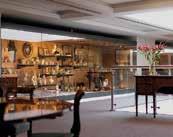



in five auctions. The Garden Rooms’ Bistro will also be bringing back its popular Yorkshire Tapas menu from mid-June, which offers diners a selection of classic Spanish dishes with a Yorkshire twist.

With a range of indoor and outdoor seating areas, make the most of the Tennants’ varied dining options, which include afternoon teas, traditional Sunday lunches and their renowned fish and chips served in the Café.

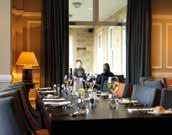

Open seven days a week and free to enter, there is always something new to discover at The Garden Rooms at Tennants.
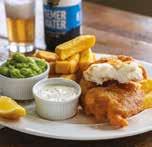
Welcome to the Summer edition of Excalibur! It feels odd to be naming this the summer edition, given that it feels as though Spring is only just upon us.
Speaking for myself, I am still not 100% convinced the weather has turned – I have sledging with my family and the biting wind chill of Catterick ranges still very much in recent memory. Nevertheless, the weather was kind to the nation for the Coronation of HM King Charles and Queen Camilla. I was spared 34 Sqn’s ceremonial and C-UAS contingents and was therefore blessed with the opportunity to
attend a party on our village green – I hope that you all found the opportunity to celebrate with friends, family or community as well.
Thank you as usual to all our contributors – I especially would like to commend AS1(T) Metcalfe’s article to you as a compelling account of what it is possible to cram into a year in the RAF.
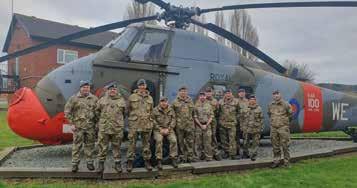
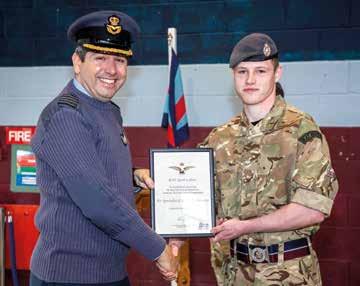

Designed by: Jo Glen


March saw RAF Leeming gain a twin-station on the other side of the Atlantic: Marine Corps Station Miramar. Following the visit of Station personnel to Miramar, and a reciprocal visit to RAF Leeming, the two stations have created an unique partnership to collaborate and support each other with experimentation to improve resilience, operational performance and training for our Aviators and their Marines.
Further recognition of our leading-edge in experimentation came in April when RAF Leeming showcased the work of the RAFX ViTAL Living Lab with Newcastle University. Over 150 people including military leaders from the UK and beyond and key industry players came together to learn how Leeming is playing a leading role in developing a sustainable, resilient and greener future. And, most importantly, the children from RAF Leeming came to participate in the day with hands on STEM learning from leading academics.
In May, we celebrated the Coronation of His Majesty King Charles III and Her Majesty The Queen. I was delighted to have so many of the team from RAF Leeming contribute to Operation Golden Orb in London. We were also able to send some members of the Leeming team to the Coronation Concert in recognition
of their achievements on Station. I was also privileged to represent Leeming and the RAF at a 21 Gun Salute in York.
If all this wasn’t enough, RAF Leeming was delighted to welcome the Chief of the Air Staff, Air Chief Marshall Wigston. In a tightly packed programme, RAF Leeming shone, showing not only the breadth and depth of what we deliver here on Station and into defence but also the quality of individuals who serve here. It was clear that the range, depth and talent of the Station impressed our guest.
Despite our geographical distance from Air Command, RAF Leeming is highly visible. The work of our Station personnel is seen, appreciated and valued. A testament to the importance of the Station is continued and ongoing investment defence make into the estate. In addition to the building work already happening on Station, we will soon embark on a project to refurbish the runway. This work will extend the life of the runway and ensure that RAF Leeming will continue to be the RAF’s northern powerhouse.
Following your feedback on communications, the Station has added some additional communications channels. The team have installed noticeboards
at three key locations on base: at the main guard room opposite Station Headquarters, outside the Junior Ranks Mess and outside the Barrel & Bean. At the more hi-tech end, electronic display boards have also been installed around the station to ensure broad and timely distribution of updates and information.
If you have further ideas for
Following your feedback on communications, the Station has added some additional communications channels. The team have installed noticeboards at three key locations on base: at the main guard room opposite Station Headquarters, outside the Junior Ranks Mess and outside the Barrel & Bean. At the more hi-tech end, electronic display boards have also been installed around the station to ensure broad and timely distribution of updates and information.
improvements or want to get involved and volunteer, bring your feedback and ideas to the Station Commander’s Forum. The next date will be shared soon and I look forward to seeing you there. Last but not least, one of the highlights of the summer here at Leeming is the chance for us all to come together, with partners, families and close friends.
This year, the newly formatted Leeming Show will bring the best parts of our previous Families’ Days together to deliver a fun-filled day for us all on Thursday 27th July. Further updates will be coming soon but for now, mark the date in your diary so you don’t miss out.
We’re over half-way through 2023 and what a year it has been already, so let’s take a moment to reflect on some of the highlights since the last edition of Excalibur.
Throughout my time here, I have been presented with numerous opportunities and challenges that expanded my skill set, that have allowed me to make a meaningful impact within the unit.
From day one, I was welcomed into a diverse community of skilled professionals, we have formed a close-knit team that has thrived on mutual respect and collective determination. Whether it was maintaining vehicles or troubleshooting complex systems, we tackled each task with unwavering camaraderie and a shared sense of purpose.
My year in question began in May 2022 with an exciting stint in the Deployment Bay. Here, I had the opportunity to service and provide deployable equipment for high-profile exercises and operations such as Op Agora and Ex Finland Ace. Being part of these critical tasks allowed me to contribute directly to the success of high profile taskings and witness first-hand the impact of our efforts on a larger scale. Also in May 2022, I was sent to RAF Witting to conduct an assessment on the required equipment for another highprofile tasking, so important that I don’t remember the name. This assignment allowed me to apply my engineering expertise and contribute to the planning and preparation of essential resources. It was a chance to showcase my skills while collaborating with fellow professionals to ensure
that all necessary equipment was available for the upcoming exercise.
Throughout the year, I had the privilege of aiding the RAF Leeming Go Kart Club. My role involved designing eyecatching posters, organizing, and marshalling events, as well as creating and ordering club T-shirts and attire. Being involved with the club allowed me to combine my engineering skills with my passion for motorsports and contribute to the recreational community within RAF Leeming.
In June 2022, I took the initiative to organize a camping trip for various members of my section in the breath-taking Lake District. Together, we embarked on an unforgettable journey, conquering the rather misleading designated ‘Hill’, Blencathra and exploring the charming town of Keswick. This outdoor adventure allowed us to decompress from the pressures of
work, creating lasting memories and a sense of unity within our small friendship group.
July brought an opportunity to celebrate with my loved ones at the RAF Leeming Families Day. Accompanied by my wife and child, we enjoyed the festivities, especially the Typhoon display, although my son protested that it was unnecessarily loud. The highlight of the night was the captivating music provided by the nights band and by the DJ Suneek. I especially enjoyed supplying the Station Commander with glow sticks so he could rave ‘correctly’.
Another highlight of July was the Junior Ranks Summer Ball, this event provided an opportunity to meet people from various sections on the unit, that I would usually not have had the opportunity to meet. To me this is always exceptionally useful because now you know someone specific to annoy if you ever need help from another section. We danced, laughed, and thoroughly enjoyed trying to one up one another on the mechanical surfboard!
Exploring the Mountains of Bavaria:
In August 2022, I had the incredible opportunity to participate in the Alpine Eagle scheme in Bavaria, Germany. The focus of the scheme was Klettersteig, a form of rock climbing that follows pre-installed climbing routes supported by
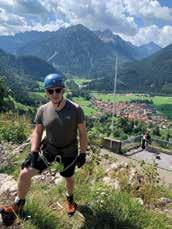
metal cables. Accompanied by two colleagues from Leeming, we embarked on an adventure that not only challenged us physically but also allowed us to immerse ourselves in the vibrant culture of Germany. Thankfully only one of us fell of and even more thankfully, it wasn’t me.
Beyond the physical aspect, the Alpine Eagle scheme also provided an opportunity to embrace the German culture and practice my language skills. Having invested time in learning German through the Duolingo app, I was able to communicate with locals and order beer very effectively.
In September, I took a significant step towards securing my future by purchasing my first house in my hometown. Recognizing the inconvenience of living in it while pursuing my career in the Royal Air Force, I made the decision to rent it out. This strategic move not only allowed me to maintain a stable home base for the future but also provided an opportunity for someone else to contribute towards my mortgage payments. A decision that I would highly recommend to fellow aviators.

Mid October 2022 I embarked on a new adventure as an individual augmentee, sent to RAF Akrotiri in Cyprus. Upon my arrival in Cyprus, I was greeted by unexpected torrential rain instead
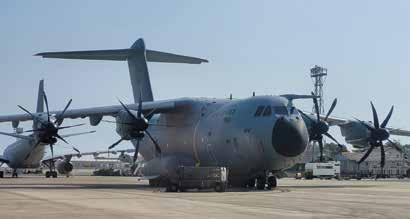
of the promised, and expected, sunshine! Undeterred, I ventured into the nearby City of Limassol and explored the surrounding areas using public transport that could only be politely referred to as “a danger to health!” These journeys, although challenging, added an element of adventure to my experience and a welcome escape from the day-to-day work. Throughout my deployment, I dedicated myself to the crucial task of fixing airfield support equipment, playing a vital role in the support of Operation Shader. Day in, and sometimes, day out, I worked diligently to ensure that the equipment was in optimal condition, ready to fulfil its crucial role. Despite the challenges and demanding nature of the work, the satisfaction of knowing that my efforts directly contributed to the success of the operation was immeasurable. However, while my contributions may not have garnered a medal, the fulfilment derived from supporting such a vital mission is, almost, reward enough.
Spending Christmas in a foreign country, far from the comfort of home, presented its own set of challenges. While the camaraderie among my fellow augmentees helped alleviate the homesickness, the absence of loved ones during the winter period served as a poignant reminder of the sacrifices we make in our role. Amidst the highs and lows of my deployment, I encountered an unexpected incident that left a lasting appreciation for our robust safety standards at GEF Leeming. While under operation,
a scissor lift battery unexpectedly exploded, creating a moment of chaos, requiring immediate action to ensure the safety of those involved. Through quick thinking we were able to swiftly mitigate the situation and ensure the wellbeing of all personnel involved. Utilizing my free time, I meticulously planned day trips and outings, inviting fellow augmentees and permanent staff to join me in exploring the wonders of Cyprus. From the picturesque Avacas Gorge, where we immersed ourselves in the tranquil beauty of nature, to the enchanting Troodos Mountain range, where we lost ourselves, figuratively and literally, in the breath-taking landscapes. Beyond the ordinary, two extraordinary opportunities presented themselves during my time away. I orchestrated a trip to the abandoned City of Famagusta, exploring the remnants of a once-vibrant community offered a glimpse into the past and a deeper appreciation for the island’s complex history. Furthermore, my unchecked enthusiasm led me to persuade a visiting aircraft section to grant me a flight in their Hercules aircraft. This exhilarating experience allowed me to actually say “you don’t have to be a pilot to fly in the RAF.” (Authors note: I actually felt nauseous writing that!)
RETURNING HOME:


Following my eventful deployment, I returned to the UK in February 2022 with a newfound appreciation for my home unit and some new ideas. However, my journey did not end there. Back at RAF Leeming, I was presented with an exciting new role as a controller in
General Engineering Flight Control. This responsibility allowed me to contribute to the efficient coordination of tasks and resources, ensuring smooth operations within the flight. In addition, I was given the opportunity to wear acting higher rank, specifically as a Corporal. Recognizing the significance of this position, I eagerly undertook the challenge and began preparing for the acting higher rank interview. After careful study and preparation, I successfully passed the interview, marking a significant milestone in my career. I now eagerly await the official confirmation of my acting rank and look forward to showcasing my professional capabilities in this new role.
AUTOMATING EFFICIENCY:
As part of my commitment showcasing my professional capabilities, I actively sought opportunities to contribute beyond my primary duties. It was during this time that I was asked to assist HR Centre 5 with a timeconsuming data entry task. Taking the initiative, I requested a few hours to explore automation possibilities for the task at hand. Utilizing my technical skills and problem-solving mindset, I partially automated system to complete the data entry task and completed, with some help, the rest. The outcome of my efforts was met with praise, as my solution significantly reduced the manual workload and saved several person-hours for the team involved.
In acknowledgement of my contributions, I was deeply honoured to receive the Station Commander’s Medal. This recognition from the station commander holds great significance to me, as it represents

a validation of my hard work, dedication, and the positive impact I have made. In addition to the Station Commander’s Medal, I was thrilled to receive further recognition being awarded Aviator of the Month for April for ESS. This was another source of immense pride to be recognized by my management for the value I bring to the team.
The past year has been the best, most productive and most rewarding of my career within the General Engineering Flight at RAF Leeming. The honour of receiving the Station Commander’s Medal and being named Aviator of the Month for April has reaffirmed my commitment to excellence and to the core values of the Royal Air Force.
I am grateful for the trust and recognition bestowed upon me by my superiors, colleagues, and the wider RAF community. These accolades serve as a reminder of the impact we can make when we strive for greatness and work together towards a common goal. As I continue my journey in the General Engineering Flight, I am eager to embrace new challenges, expand my skills, and make a lasting contribution to the unit. The recognition I have received only fuels my determination to continue surpassing expectations and serving as a role model for my fellow aviators.
With the support of my colleagues and the inspiration derived from these accolades, I am confident that the coming year will be marked by further growth, achievement, and a continued commitment to excellence within the General Engineering Flight at RAF Leeming.
AS1(T) Gary Metcalfe
The below article is advice directed at industry, but it equally applies to us in the Forces community. In fact, is very timely advice for us as in some respects our changing work processes and patterns are contrary to the advice below. Can you spot this?
As a Padre with a strong interest in promoting good mental health and spiritual resilience I commend to you all the hygge principles below.
In 2017 Denmark’s status ws to be marked as the happiest nation in the world. This was certainly attributed to the growing trend and popularity of using hygge – the art of enjoying every day life. The concept has spread far from Denmark’s boarders across the world.
As happy employees are not only more helpful, engaged and motivated, but also more creative, calmer and less likely to call in sick, why not use the concept to spread a little a little happiness and wellbeing across your workforce.
1
FOCUS ON THE POSITIVE
When friends come together to enjoy hygge, talking about stressful topic is rare. Unfortunately, at work and in life, its’s all too easy to focus on what we have not achieved, instead of what we have.
A powerful, hygge inspired exercise is therefore to encourage employees to note the positive things that happen each day. Doing this regularly reprogrammes the brain to focus on the positive, which has been proven to boost happiness levels and increase our resilience to stress and anxiety.
2BE KIND TO YOURSELF
Instead of constantly chasing achievement, hygge is about taking time for yourself to create a sense of personal contentment. Whether its fully disconnecting from work once you leave the office, taking a proper lunch
hour or rewarding yourself after competing a task with a break to do something you enjoy for 10 minutes. That’s easier said than done with our busy lives and over work culture, so why not give employees ‘permission’ to be kind to themselves by asking leaders across the organisation to roleplay positive behaviours. Or you could run a competition that rewards the best examples of employees being kind to themselves, such as giving themselves an achievable deadline, instead of pushing themselves past their personal limits.
exposed to distractions, form the constant flow of information, emails to interruptions from people who want immediate answers to things that could wait. To counter this you could consider running a mindfulness workshop or activity to teach employees how to give up multi-tasking by immersing themselves in just one activity at a time.
Constant multi-tasking has become a way of life, but a major principle of hygge is about living fully in the moment – a concept we know as mindfulness. This is particularly difficult to do at work because we are constantly
Another aspect of hygge is by boosting energy levels by focusing on things that are personally meaningful. Ask employees to find more meaning in their work by getting them to think about what activities make them feel the most motivated and energised. Then consider introducing strengths-based performance management and development processes to get them to do more of what they are naturally gifted and enjoy doing. As the Danes know, the simple fact is we are more motivated, energised and likely to succeed when we focus on the things that we enjoy doing than when we try to force ourselves to do things we don’t really enjoy.
Humans are built to be social. Its when we grow isolated from others that we get into trouble and become much more likely to experience low moods. While snuggling under blankets to watch a movie might be stretch too far for some colleagues, employees can do much more to bring employees together , from creating shared spaces for eating togetherinstead of in isolation at our desk –to reward people for helping and supporting each other.
Padre David Haslam joined the ‘Spirit of Falmouth,’ a 96 tonne tall ship and sailed with Service Personnel around the Cornish coastline. After being welcomed on board the tall ship set sail with a fair wind for a week of personal reflection, recuperation, thought and enjoyment. Participants experienced fair winds under full sail, sunshine, occasional rain and quiet overnight anchorages amid stunning scenery.
The resident crew and skipper from the charity ‘Turn to Starboard’ were wonderful hosts. You could participate in hoisting the sails as a ‘sweater’ or ‘tailer’, steering the ship as helm and more or just relax and enjoy solitude or ships company. With breakfast, bacon bap brunch whilst underway, lunch at anchor and amazing cooked suppers…. the meals were part of the whole experience.
Whilst at anchor you could set off to explore in the ships tender, climb the rigging or brave a


bracing-invigorating swim. This is just a part of the resilience provision that Ocean and Sea Eagle provide. Padre David was present to offer spiritual resilience, promote mental health and wellbeing and just loitering as Padre’s do.
Turn to Starboard, the charity that runs Spirit of Falmouth, is in itself well founded in the profound and purposeful work it does with veterans to improve lives, health and wellbeing of its many clients. Some in turn becoming volunteer helpers and even trained staff members themselves.
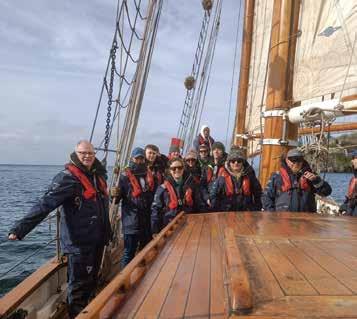
I heartily recommend giving this scheme a try. The Eagle runs over 3 days or one week event. Enquiries can be made via the advertisements seen on the gym notice boards which direct you to the intranet site etc.


The Squadron is now well and truly into a steady state routine of Counter Uncrewed Aerial Systems (C-UAS) operations. March saw us welcome back one of the first C-UAS teams to operationally deploy. Having successfully fielded the new RAPID SENTRY missile system on Operation SHADER for the first time, the troops were presented with their Campaign Medals Iraq/Syria with Clasp by the Stn Cdr. With families

in attendance, it was a proud moment for the recipients, loved ones and the Sqn alike. March’s honours and awards ceremony also saw AS1 Crompton awarded with his RAF Sports Colours for Brazilian Jiu-Jitsu. A massive congratulations to him for achieving such a high level in this exciting and challenging sport. Gone are the days of the unit formed up together for largescale activities and exercises, making way instead for constantly

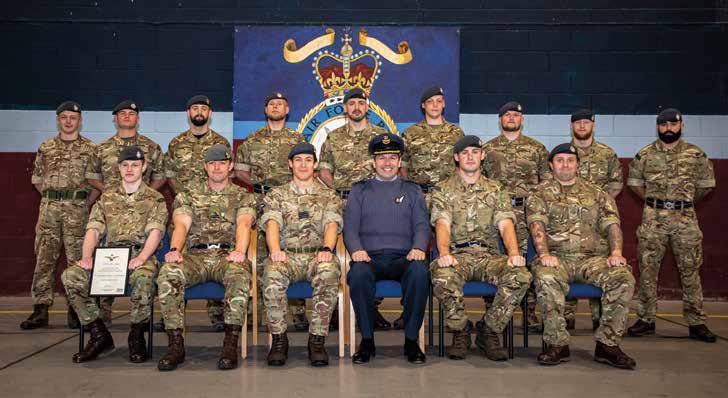
evolving training serials involving smaller teams. When the Sqn does manage to train collectively, however, everyone seizes the opportunity to build cohesion. This was particularly true in April, which saw the Sqn (well, about half of it!) undergo a live-firing package on Catterick Training Area, alongside colleagues from 63 (King’s Colour) Sqn RAF Regt and 609 RAuxAF Sqn. Being Catterick, the weather was… varied. Cpl Lewton, Range
Conducting Officer for much of the first week’s firing, displayed an impressively healthy ‘glow’ after many days stood in the high winds at Peatfell Range with little respite. In contrast, week two saw dry and warm conditions sufficient to result in a small (and quickly contained!) fire on Gayles range during the Fire-Team Attack shoots.
was a massive effort across Defence, with 34 Sqn also playing its part. As a former member of the King’s Colour Squadron, the Sqn WO played a central role to the preparation, training and taking part in the RAF’s marching contingent. 34 Sqn also sent a small number of gunners to form part of the RAF Regiment’s marching contingent – a once in a lifetime opportunity to be part of an historic moment.
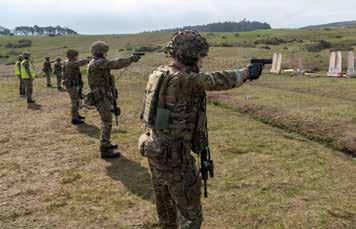
Beyond ceremonial duties, members of the Sqn also
deployed to London in a C-UAS capacity, supporting the Metropolitan Police during the Coronation. C-UAS operations within the UK are becoming a steady drumbeat for 34 Sqn personnel – since the last issue the unit has also provided direct support to high profile VIP visits to the UK and the Eurovision Song Contest in Liverpool.

This latter deployment, commanded by Merseyside native Flt Lt Cragg, saw some of the Sqn’s C-UAS equipment deployed

in central Liverpool, overlooking the contest venue. Whilst not the type of ‘deployment’ normally associated with the RAF Regiment, security of the contest against aerial threats was key due to the political significance in hosting


the event. The deployment also posed some unique challenges – suffice to say that working at heights training is paying off.
Feu de FerOn Saturday 11th February 2023 members of 607 Sqn Supply Flt & MT Flt left RAF Leeming to attend the Tactical Supply Wing (TSW) Capability Day at MOD Stafford.
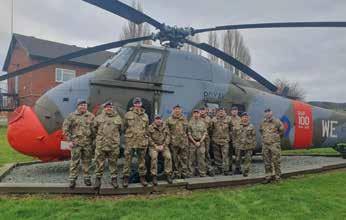
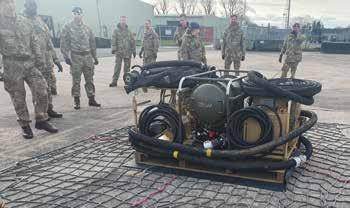
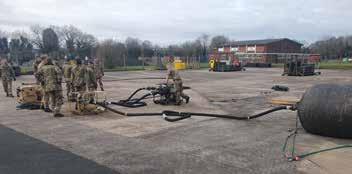
The objective of the visit was to provide an overview to Reserve Sqns of the Roles and Responsibilities of TSW and how as a reservist could integrate within the Wing, to gauge interest in possible deployment opportunities with TSW. Kickstarting the day was an Overview of the structure of TSW, its capabilities in conducting aircraft refuelling within the U.K. & overseas both on deployments and Exercise support. Splitting into four groups, there were four learning stands to visit during the remainder of the day. This consisted of the following stands and the objective learning outcomes:
MT Vehicle Stand
• Types of vehicles with Fuel tank capabilities including Oshkosh and SVs.
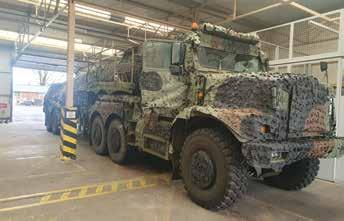
• Off Road Capability and cam and concealment in various deployed locations.
• In depth battle picture of vehicle movements to ensure forward locations can keep up with aircraft
movements to ensure refuelling can keep up with the battle picture.
JOF L/F Demo at Helicopter Landing Site
• Understanding of Joint Operational Fuel Systems (JOFS) that can be flown in to the Tactical Refuel Areas, carried as an underslung load by rotary wing aircraft.
• Physical preparation of a load to be underslung.
• Demonstration of how to connect “bladders” through hoses and Power Unit through to refuelling tank.
• Importance of earthing all equipment to prevent static and sparks for the safety of the aircraft and personnel involved.
• TSW are effectively a fuel station for aircraft. They will be in position for a maximum of 3 hours with a 15-minute window to fuel the aircraft.
• How the teams do not carry any spares as it would reduce capacity of aircraft space, and a demonstration of how to make
sure the kit they use is serviceable before it goes out of the door by inspection and preparation.
Heli Landing Point Designation
• Overview of an area the size of a football or rugby pitch is needed to operate in and how this is selected.
• Team participation to mark out the HLS with the use sandbags and cyalumes. Specialist kit with infrared lighting demonstration which is only visible only to the helicopter crew. Teams also created a NATO T and Desert Box landing sites.
• Considerations were explained in respect of firmness of the ground, FOD and surrounding approach angles which must be no more than a 6-degree incline. Other considerations included wind speed & direction, obstacles such as trees and buildings and personal kit.
• Further demonstrations included the prevention of accidents involving rotor blades. Personnel must approach the aircraft from the correct angles as directed Quality Assurance Demo
Six personnel from each team had the opportunity to conduct quality checks using a range of specialist kit. A combination

of maths and science was used to consider temperature differences, check the suitability of the fuel sample and to ensure any water was removed to ensure no failures in the fuel system of an aircraft could occur.
Summary
The day was well received by all personnel who left with a greater knowledge of the capabilities offered by TSW. All stands were presented in the upmost professional manner by highly trained personnel who encouraged team participation with questions and answers and physical involvement.
Sgt Kris ‘Topsy’ Turvey, a Logistics Chef Part Time Volunteer Reservist from 607 Sqn at RAF Leeming recently supported the Defence Medical Academy during Ex DRAGON GALLIC SERPENT, a 2 week overseas Adventurous Training (AT) Exercise to ARDECHE and PROVENCE, southern FRANCE.
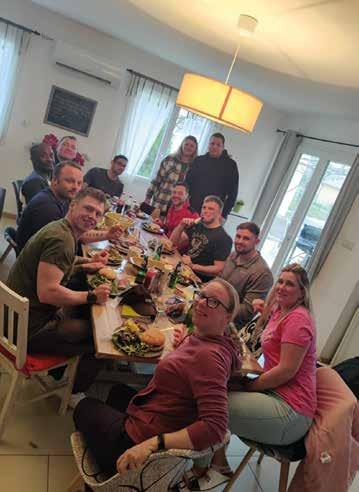
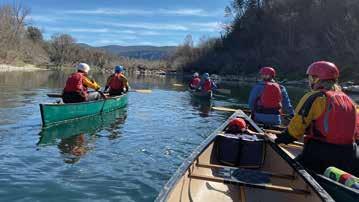
Sgt Turvey’s role was to provide catering for all exercise participants, he had the following to say about the Exercise.
On departing DMS Whittington, Lichfield with a mix of medic and dental practitioners from all services, we set of on our self-drive travel to the south of France via Calais and a ferry from Dover. What followed was an epic 22hr journey to our final destination through the French countryside and picturesque mountains, with only a few issues along the way regarding fuel, toll roads and the difficulty in having to drive on the wrong side of the road! We spent the first week in Vouge region town of Aubenas, where the team
would be learning to canoe down the Aubenas river. A few days learning the basics on a boating lake and away we went, a 8km paddle followed by 14km and 23km to end on the final day. For the second part of the AT, Rock climbing over several challenging rockfaces were scheduled. Whilst enjoying the French lifestyle for 2 weeks, my duties included driving to and from drop of points, chef duties - from sourcing local rations (an interesting task given my very limited French language ability) and cooking in the evening from a small domestic kitchen and BBQ grills. This was a fantastic opportunity for any reservist to experience and I would fully recommend that you apply for the next one.
The winner of our recent photo competition is Mike Gaukwin and this fantatstic image is of Indian Mirages taxiing out for a Cobra Warrior exercise at RAF Waddington.

Congratulations Mike!
www.rafmags.co.uk


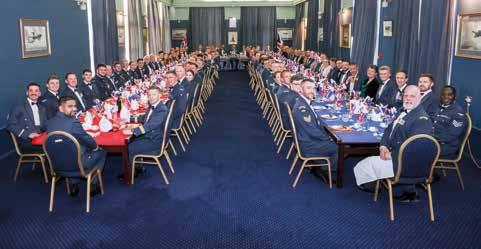
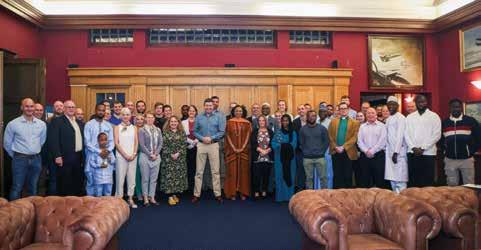
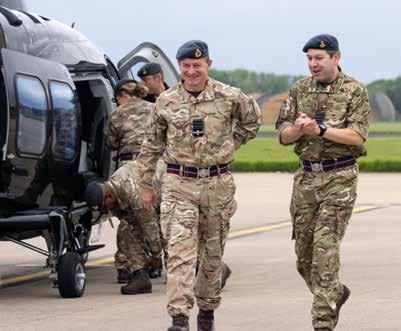
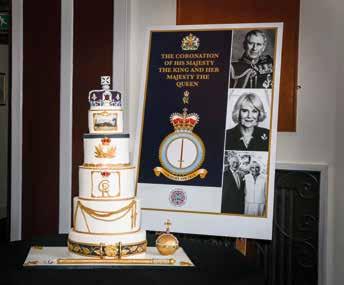

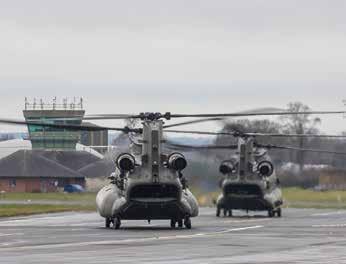
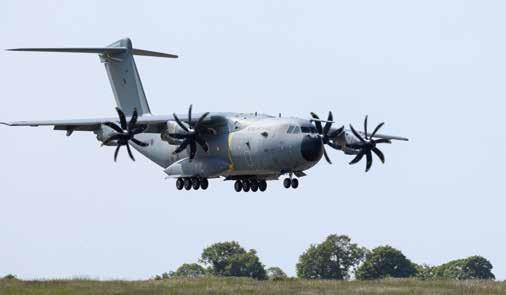
As part of the Coronation Day of Queen Elizabeth II, five Airman took part in the Coronation Parade on 2 Jun 1953, Fast forward to 2023, Op GOLDEN ORB, three Junior Ranks from 591SU were selected to be part of the RAF’s coronation marching contingent.
Leading up to the assembly date of Thursday 27th April, all involved were excited to be participating in such a historic event.



After meeting those travelling down from RAF Waddington, which included personnel from 13 Squadron, the ASWC and the RAF Regiment Reserves, amongst others, they headed down to RAF Halton for the upcoming fun and games.

The start of the drill practice began with a re-cap for the majority, and then a realisation set in with just how many people had descended on Halton to do some marching. The RAF Regiment, RAuxAF, RAF Halton, and the wider RAF, each had a 92-person marching contingent, along with a smaller contingent from RAFC Cranwell. Alongside that, was a 300 strong contingent from RAF
Cosford, who were unfortunate enough to be on Route Lining Detail. An unenviable task that no one marching wanted to swap in for.
When the marching practice began in earnest, ‘Happy Valley,’ as the route between RTS and the bottom site at Halton is affectionately known as by the drill staff, soon became known as ‘Blister Boulevard.’ The accumulation of marching for 10 miles a day was soon taking its toll on everyone’s feet!
On the Sunday it was an early start and a trip to RAF Odiham for a massed rehearsal which included personnel from all three services and the Commonwealth personnel involved. Looking back down the runway once the RAF marching contingent turned onto the taxiway and seeing that the tail of the procession had not yet
even reached where they began, emphasised how this coronation event was the largest military procession in the UK for quite some time, with approximately 4000 military personnel present!
Tuesday night and Wednesday morning saw the massed rehearsal move to the streets of London. Those at Halton got on the train and travelled into Waterloo station to an enthusiastic crowd which heightened the morale and pride felt by those participating. With the drums beating and the bands playing whilst marching over Westminster Bridge, it was hitting home just how big an event this really was.
Following a media day on the Thursday and a final run through with further kit prep on the Friday, it was an 0300Hrs breakfast on Saturday ready for the main event. After marching their way to
Westminster Chapel for a welldeserved second breakfast, it was an 1120Hrs assembly time for the finale. More drums and music got them setup at Admiralty Arch ready for the Majesty the King to be returned to Buckingham Palace in the State Coach via the Mall. After 55 minutes of waiting patiently at the Arch, they stepped off together to a raucous crowd along the Mall and into the Palace gardens. Waiting for all the marching troops to arrive in the gardens once again displayed the sheer number of troops involved. Emphasised further still, by the reverberating shockwave from 4000 bellowing troops giving three cheers to their new Commander in Chief washing back over them. A moment the new Monarch was visibly taken aback by. And a moment that will be a lasting memory for all involved.
This has been another diverse period for 609 Sqn personnel. The increasingly close ties the squadron has with its sister squadron, 34 Sqn RAF Regt, has begun to demonstrate the mutual benefits that can be achieved. This is affording our reservists the opportunity to conduct pre-deployment training and C-UAS training alongside their regular counterparts, who they subsequently deploy with. In return for this training 609 Sqn support them with 4 trained personnel every 6-months for overseas operations, along with individuals to deploy on various tasks in the UK aiding the civil authorities.
Along with this operationally focussed training, the squadron must focus it training weekends on achieving all the baseline mandatory training for both RAF Police and RAF Regt personnel. Close collaboration between 607 and 609 Sqn is also beginning to reap benefits, for example that they were able to facilitate our training; but there is much more going on behind the scenes in terms of Employer Engagement which will be spoke about more in upcoming articles.
Cpl Mair (PTVR) and Cpl Ferguson (FTRS) both from 609 (WR) Sqn were lucky enough to be selected to take part in OP GOLDEN ORB as only 1 in 30 applicants were selected to march in the King’s Coronation precession.
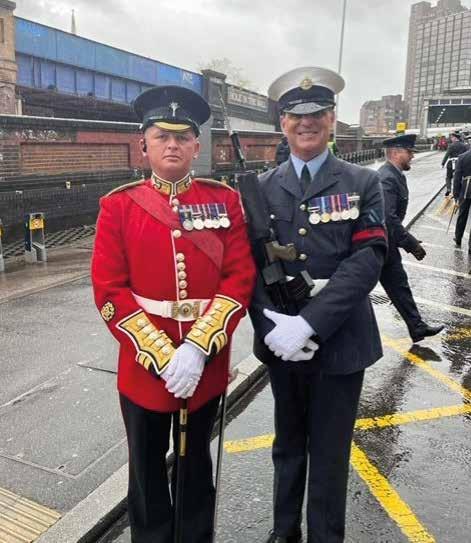
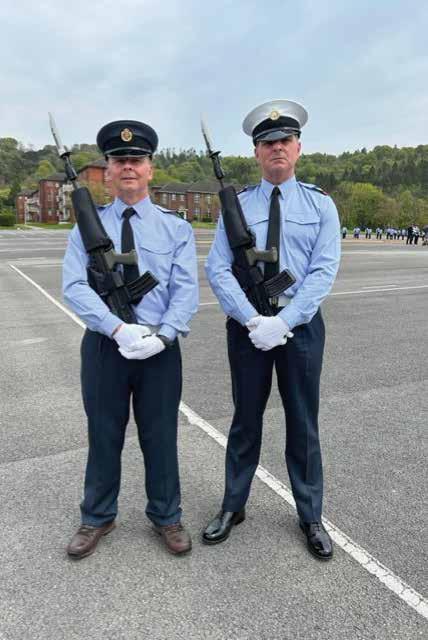
Training consisted of refresher foot and rifle drill sessions conducted by RAF Halton ceremonial drill staff. This culminated with putting these individual skills into practice for the planned foot manoeuvres relevant to marching in 12 formations down the Mall. This included re-forming into 4 formations and then back to 12 whilst marching through the Admiralty Arches before forming into 6 for marching into Buckingham Palace back garden. This was practiced both at RAF Odiham runway during the day on Sunday and as a full night practice on the streets on London on Tuesday night into Wednesday morning.
Training was intense, with early starts at 0500 in order to manage the huge issue of weapons from the armoury, and the logistical problem of feeding a thousand
personnel for breakfast. During our foot drill training, including the event itself, we marched a total distance of 74.192 miles and burned approx. 46,346 KCal in energy. Foot management was key throughout. One evening a total of 74 personnel had to visit the duty medics for blister management. Although Cpl Ferguson and I were OK, we still took advantage of the decision to allow us to wear trainers for some of the training to save our feet.
Coronation day itself started at 0245, where we were all transported by rail from Tring to Waterloo station. We then marched en masse as an RAF contingent across Waterloo bridge and up to Westminster Chapel
via Wellington Barracks. Here we were fed and watered until our step off time at 1130. From here we marched up the Mall, through Admiralty arch and halted on Whitehall. From here we about turned and marched back down the Mall in the main precession through into Buckingham Place back gardens, where we gathered with all the other forces and gave 3 cheers to His Majesty.
It was a fantastic day, albeit rather a damp, however it was an amazing opportunity to be a part of history. I even manged to make it all the way without stepping in the horse poo for the full length of the Mall.
Cpl Mair (RAFP)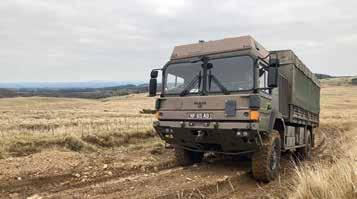
Thanks to a combined effort between 609 and 607 Sqn’s Mechanical Transport NCOs, two members of 609 Sqn were able to receive conversion training for the M.A.N 6-Tonne Support Vehicle. A category C driving licence is required to drive this type of vehicle which is a highly capable all terrain truck that can be configured for a wide range of roles including troop carrying and simple logistics load layouts.
The training course started with an instructional period on how to prepare the vehicle for the road going from a daily driver’s inspection which included checking all the lights, safety and braking systems, tyres, storage lockers, security of additional panelling etc. Students were also taught to safely tip the cab to gain access to the engine for further inspections and maintenance. The final part of the lesson covered lowering the spare wheel for a wheel change should the need arise.
The second part of training was the driving element. After familiarisation with the driving controls and the automatic/ semi-
automatic gearbox the students headed out onto the road paired with an instructor. We followed a pre-planned route that was deliberately chosen to include dual carriageways, A-roads, and smaller country lanes. This allowed the drivers to get a feel of when and how to use the gearbox in different modes.
Moving into the second day, the training switched from driving on the road to driving off road. After the initial road move to the training area and a thorough safety brief, the training was able to take place with the instructors giving advice on how to negotiate the various obstacles and mixed terrain. It was sometimes necessary to exit the vehicle to check wading depths. The combination of theory, good instruction, diving on and off the road left the students feeling well prepared and confident for operating the vehicle and should prove a good resource for the Squadron to utilize in the future.
Cpl DoughtyThe objectives for this training weekend were to practise Fire and Manoeuvre in pairs and fire teams to prepare for transitioning to live firing and then subsequent operations. The training was conducted at Catterick Training Area (CTA).
After parade on Saturday morning, we collected our weapons and travelled to CTA. The ground was covered with several inches of snow, and it was cold but sunny for most of the day. However, once the training started, we soon warmed up. It was great to get back out in the field and shake off the cobwebs with your personal F&M drills as it has been a while since the Sqn has had a chance to do so.
After initial rehearsals, fire lanes with pairs were conducted, which again were great refreshers and helped get you into the right frame of mind for reacting to effective incoming fire, locating the enemy, suppressing and assaulting their positions. Later in the afternoon we practised patrolling as a section and dealing with enemy contact. A hot lock was provided for tea, and it was very welcome to get hot food and drinks inside you in the cold conditions.
The section patrolling was repeated when night fell so that Night Vision Aids (NVAs) could be used and practised with. For many, it was the first time using
NVAs with the Virtus helmet and using the counterweight at the rear of the helmet. Flares lit up the night sky and the effects were impressive – allowing more enemy position to be identified and engaged. Once these night serials were complete, we returned to back to RAF Leeming.
Sunday saw the clean-up of the site and weapons and vehicles. The exercises had been filmed and we reviewed the footage in a debrief. This was particularly useful in picking out good and bad points in the scenarios. There was a lot of positive learning from the weekend, be it refreshing your personal skills for F&M, getting to grips with the Virtus kit, performing in adverse weather, working in a team, taking the lead in the patrol, or making decisions on the ground when under contact.
AS1 Hunter (RAF Regt)
Evidence bags, blacked out goggles, Captured Persons (CPers) paperwork and rubber gloves were amongst the RAF Police kit packed into a webbing pouch prior to attending the 609 Sqn Combined Incident Team (CIT) training weekend.
Upon arrival at the training area, one of the first sessions to complete was for everyone to have a weapon handling test on trip flares and grenades, which having not previously been taught, was an opportunity to learn and be assessed on something new. Being fully
embedded into a section for the whole weekend, the RAFP would participate in all roles, including manning Observation Posts (OPs), Control Of Entry, carrying out fire picket duties and foot patrols of the area. It also gave the RAFP the opportunity to ask questions and brush up on their ‘green skills’ and pick up some hints for living in the field from other section members.
Throughout the weekend the RAFP were required to draw on their trade specific knowledge which was needed on a patrol when there was a CPers to deal with. Having RAFP within the
section enabled the medics, commanders and other troops to focus on their roles, whilst RAFP ensured that the CPers and evidence were handled correctly, and the supporting documentation completed. This included making notes of any relevant timings, who had previously handled any evidence and dealt with CPers for their specific roles before the RAFP arrived at the scene, and ensuring the integrity of the evidence was maintained as much as possible.
As the patrol continued its tasking, the RAFP were able to take
custody of the CPers and ensure a thorough search was carried out prior to handing over to the Detainee Handling Unit personnel correctly.
The whole exercise was a great opportunity for the RAFP to recognise other considerations and contributing factors which affect our specific duties in this particular situation, whilst also increasing awareness of all the other section and flight members roles and the importance of them working together.
Sgt Julie MillottThe continuing development of personnel is of high importance to all RAF Regt Sqns and time on the range is vital for enhancing individuals shooting skills. Thanks to the combined efforts of the training teams from 609 Sqn and 34 Sqn, a comprehensive 6-day training and range package was organised to cover the L85 rifle and Glock 17 pistol.
Pistol training was carried out for squadron personnel who had not yet undertaken it. This included all the relevant safety precautions, stripping and assembling, function, and operation. Critically, we learned about the three internal safety systems the Glock has, trigger safety, firing pin safety and drop safety. The holster for the pistol is also an important part of the weapon system and is included in the training package. It has three safety features Top lock, Side lock and Lanyard attachment. Once all the students were confident on all the aspects of using the pistol weapons handling tests were completed.
The first day on the range was conducted in the DCCT (Dismounted Close Combat Trainer) which is an indoor electronic firing range. The DCCT is treated and run exactly the same as any other live firing range and it is an excellent tool which can run various different programs for developing shooting skill and overall weapons handling techniques. Troops were able to work their way through developmental shoots including moving targets.
The second stage was conducted at RAF Boulmer on the 25-meter range. The focus for this range was Glock pistol Annual Combat Marksmanship Test (ACMT), Close


Quarter Battle, and rifle to pistol transition shoots. Firers were able to get used to engaging targets with the pistol from different firing positions and shooting one handed to simulate being in confined spaces etc. The Rifle was then brought in as primary weapon and drills were practiced including turning from position to engage a target from a different direction. Finally transition from the rifle to pistol was done to simulate a stoppage at close quarters.
The next part of the range package firers would be shooting with the L85 rifle up to 300 meters. Preparation for the ACMT was conducted first followed by the test itself. Once all firers had passed the ACMT a respirator shoot was undertaken using the general service respirator. Moving into the evening a limited visibility shoot was done followed after dark by a night shoot. The night shoot involved using the Helmet Mounted Night Vision System (HMNVS) in conjunction with the Laser Light Module (LLM). The familiarisation and set up of the night vision aids was critical as these would be used later in the range package live field firing.
The first part of Live Firing Tactical Training was conducted on the Individual Battle Skills Range (IBSR). This range allows troops to fire using different types of cover as individuals and then moving on to pairs fire and movement. The final part of the range package was fire team day and night. This was a culmination of everything that had been taught and practiced. Carried out initially during the day, a 4-person fire team was given a mission brief and an axis of advance to patrol along. Contact with the enemy was simulated by targets popping up. Patrol commanders would then have to give fire control orders and come up with a plan to carry on. If enemy strength was too strong the fire team would need to withdraw. After darkness fell a very similar mission was undertaken using night vision aids and LLMs. Ultimately this was a highly effective and enjoyable range package which has improved all participants’ skill at arms.


We had a rare visitor to Leeming on 11th May. It wasn’t a 2 star on a visit or an unusual aircraft, but a funnel cloud. Kudos to ATC who were first to spot it just to the north of the airfield.
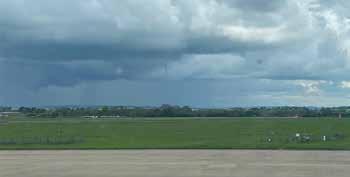
Funnel clouds, also known as tuba from the Latin for trumpet, develop in unstable airmasses when deep convective cloud such as Cumulonimbus, heavy showers and thunderstorms develop readily. We had such an airmass that day and funnel clouds were also reported at Barkston Heath and Humberside airport. These form at the base of the Cumulonimbus cloud when
the column of swirling air begins to rotate allowing the moisture in the air to condense into water droplets giving the recognisable shape of a funnel cloud. Fortunately for us it didn’t last long or reach the ground, if it had it would’ve been classed as a tornado. Tornadoes are surprisingly common in the UK occurring around 30-35 times a year. These are usually much less intense than the ones that can cause devastation in the mid-west United States but can still create very strong winds and cause damage to infrastructure. Look carefully, can you see the funnel cloud in the middle of the picture?
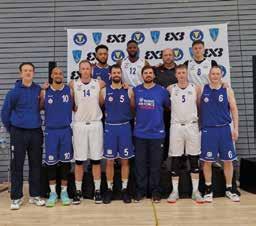
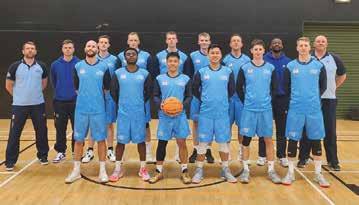

Iam lucky to say that such an opportunity has been afforded to me as I barely get my feet under the desk as the new Int Flt Cdr on 607 (County of Durham) RAuxAF Sqn. As a regular serviceman, I represented the Royal Air Force and UK Armed Forces at Basketball through my entire 18year career and once I attested into the volunteer reserves, the RAF Basketball Association welcomed my experience and continued involvement as it strives to improve its output on the court.

6 - 10 March 23, I travelled to Ramstein Air Force Base, Germany to coach the RAF Mens’ Team in the HQ AIRCOM International Basketball Championships. Due to funding constraints, for the first time, this tournament was played in the 3 v 3 format as opposed to the traditional 5 v 5 format that most basketball fans worldwide are accustomed to. That said, 3 v 3 basketball is now huge around the globe and continues to grow with its recent addition as an Olympic sport. This proved to be a fantastic event, with the US Air Force being superb hosts to military teams from the US, UK, Belgium, Germany, Poland and The Netherlands. With this being the first time many of the RAF participants had played an official 3 v 3 Basketball Tournament, the focus for me as the coach was for the players to keep things simple and use their strengths from the traditional 5 v 5 format to try to overcome the opposition.
They did exactly that and represented the RAF commendably as they Won 3 of their 6 games on route to the final of the competition. They beat the The Royal Netherlands Air Force, The US Air Force and their Semi-Final opponents, The Polish Air Force. Apart from the obvious high of getting to the Tournament’s Final for only the 2nd time in its history, a clear highlight was to beat the US Air Force on their home court with a raucous crowd behind them! Regrettably, the task of beating the German Air Force, which included two professional players was a bridge too far with the Final finishing RAF 11 – 18 GAF. 22 – 23 April 23 saw the Army host the annual Inter-Service Competition at Aldershot Garrison Sports Centre. The RAF plan for this tournament with a week-long training camp at RAF Cosford
to the competition and although attending in my official capacity as the RAF Men’s Team Assistant Coach, I was convinced to also dust my pearly white boots off and play for the RAF this season. It will not escape many people that know me that I am only just the right side of 40 (depending on how you look at it) and so taking on such a training camp which often involves three training sessions per day is a huge undertaking, but in the spirit of ‘Per Ardua Ad Astra’ I agreed to play seriously for the first time
in over two years and but for a rusty offensive game and few creaky bones, all was well with the world...... Alas, after a very competitive and hard fought game against the Royal Navy on 22 April, which ended with a 83 –87 loss, we had to play the Army 4 hours later and regrettably as a team we just could not muster the energy to mount a serious challenge against an aggressive and fresh legged opponent. The Army played the Royal Navy the next day and came out worthy winners of this year’s Mens’ tournament. There was much to celebrate from a Royal Air Force perspective however, as the RAF Ladies and RAF Under 23 men’s team won their respective competitions. So overall that goes down as a Royal Air Force Inter Service Victory, hoorah!
That volunteer reserves (twice the citizen!) can attain duty status to complete such activities whilst building new friendships from around the Services or continuing friendships previously made, is a very good news story for those who play or coach sport at the representative level. With that in mind, I offer my sincere thanks to Sqn Ldr Graeme Deighton for his support in allowing me to continue my sporting endeavours whilst first and foremost serving under him in his role as OC 607 Sqn.
Flt Lt Craig ‘Percy’ Percival Int Flt Cdr 607 Sqn
With sport being such a huge part of regular service life, it is fitting that reserve personnel are also afforded the opportunity to play sport in a military environment.
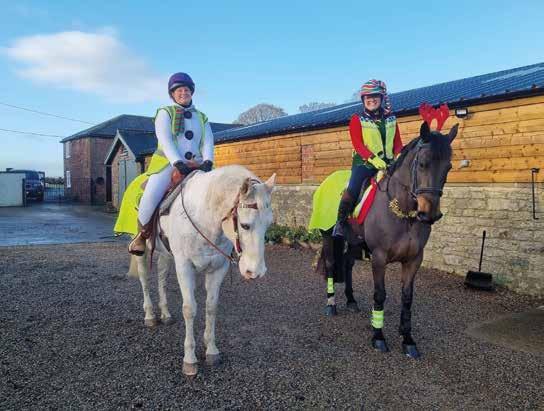
This story starts where most about horses and ponies begin: with a fascinated child who will do anything for the animal she loves including flying for her four-legged friend across the world!
Iwas born and raised in Canada and travelled for work and pleasure in my twenties. While working in the U.K. I met my now-husband, and we undertook a long-distance relationship whilst I completed my University studies in Canada and he continued in his RAF career.
When the inevitable proposal and wedding was scheduled, there was never a discussion about where to live: I was moving to the U.K., but what was I going to do about my beloved childhood horse, Paco? Anyone who has truly and deeply loved an animal knows that inexplicable sense of guilt when you leave to go on holiday: ‘I can’t leave them’, ‘He’s going to be so sad without me’ and ‘What if something happens while I’m away?’. With a horse you can’t exactly put them into a crate and have them fly in the cargo hold of your British Airways plane. I needed some professional assistance.
After a few years of living in the UK, we were posted to RAF Leeming and I was really missing my boy. I started contacting professionals, liaising with family and friends and began to coordinate the logistics of bringing him over from Canada. I spoke to several companies who export and ship horses internationally
and selected one who were able to outline a plan that balanced a well-considered itinerary and cost whilst offering wonderful support throughout: Their office in Newmarket regularly ship racehorses between America and the U.K. so it was reassuring to know there would be someone to speak to if any problems arose. I was also incredibly lucky to have had immense emotional support
from the RAF Leeming Saddle Club.
Like with all animals travelling between countries there were the inevitable pre-export vaccines and vet-checks to make sure Paco (who is now 23 years old) was well-enough for the stresses of travel. My dedicated parents helped pack up various belongings that would be shipped to the U.K. ahead of Paco’s arrival. Paco then had a 650-mile journey with a transport company from near Toronto, Canada to Lexington, Kentucky in U.S.A – due to delays at the border it took a whopping 17 hours! He then needed to be in quarantine for 30 days and was lucky enough to spend this time at a stable visited upon several occasions by the late Queen Elizabeth II; he truly did enjoy his respite in a place fit for royalty! I was very fortunate that the 4th generation family who run the operation
provided regular updates and sent photos throughout Paco’s time in quarantine of him enjoying the wide-open space.
The day for his flight arrived and Paco was loaded onto a lorry and sent to a nearby international airport. Security for shipping animals is like the airport checks we go through at an airport: his ID was verified by checking his micro-chip against his travel documents; his vaccination status and export paperwork was in order before given the final walk around a secured area to stretch before being loaded into a specially designed freight container.
Designed with moveable partitions the freight container he travelled on held 3 horses side by side: in total there were 6 containers of horses on his dedicated cargo plane, a McDonnell-Douglas DC-10

operated by Fed-Ex. The freight containers are loaded one at a time into the hold of the plane using a specialised lift and track system before each container is secured.
The flight travels with a dedicated veterinarynurse who doubles as a groom that regularly checks the horses are eating and drinking and monitors their vital signs, prepared and authorised to administer medical assistance if it’s required.
Interestingly, horses tend to travel better on planes than they do horse boxes on a road: aside from the forces of take-off and landing and some minor turbulence, they experience very little disturbance. Compared to the acceleration, deceleration, changes in forces from turning corners and bumps from potholes in the road, standing in the freight container on the flight is far more enjoyable.
Paco’s flight landed at London Stansted airport early-evening on a Tuesday and the process to take the horses off the plane is a reverse of how they are loaded: the freight containers are off-loaded and brought to a processing area before vital signs are checked, ID’s verified and then handed over to whomever is collecting them. Most of the horses were collected by transport companies, however, I was incredibly fortunate to have generous friends who loaned me a horse-box and the Saddle Club’s OIC, FS Ange Polgreen, chauffeured us from RAF Leeming to Stansted and back.
In the days following his arrival to the U.K., Paco had a vet appointment to check his vital
signs and a physiotherapy appointment to massage out the tension he was carrying in his body following the stress of the move. With a detailed and specific rehab plan in hand from Paco’s physio we began light work to slowly release the stiffness and tension in his body so that he could loosen off and begin to do strength training before I could begin riding him again. Fast forward through the winter and while we still have a long way to go, Paco is much stronger and getting more supple which will only make it easier to progressively build his muscle and stamina.
When I bought Paco I was 15 years old and he was 4 and a half. I never could have imagined the future we have together now twenty years later. Almost every day when I’m leading him to his grassy paddock with English oak trees or when I’m brushing out his constantly knotted tail, I have a ‘pinch me’ moment. The dreams of this madly horse-obsessed little girl came true thanks a fateful encounter meeting my RAF husband all those years ago.
The last few months have been a busy time for RAF Leeming Saddle Club. We have had a change of committee with Flight Sergeant Polgreen taking over the OIC role and better weather encouraging us to get out and about more!
Just a taster of what we have been up to:
• Show jumping training at Northallerton Equestrian Centre
• Trip to the horse simulator at the Unicorn Centre looking at rider symmetry and use of aids

• Lessons for all levels at The Hollies, Richmond
• Dressage training with Vicki Brown at Catterick
* Riders and supporters went down to the RAF Championships 2023 in Sparsholt competing in dressage and jumping

• AS1 Holly Croall went to support our military riders completing in the Royal Windsor Horse Show
• Mechanical horse sessions on ‘Ruby’ at Yorkshire Riding Centre focusing on balance and strength training
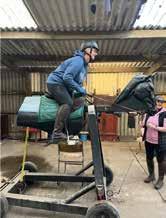
COMING UP….
• UK Armed Forces Dressage Championship at Weston Lawns
• 3 day camp at The Hollies, Richmond-for absolute beginners to the advanced rider
• Social trip to Bramham
International Horse Trials
• Lessons for beginners and intermediate riders
We offer lots of activities for people with and without their own horse and always looking for new members. Contact FS Polgreen for more information: (angela.polgreen839@mod.gov.uk
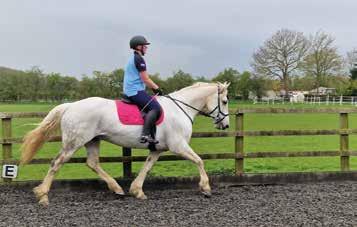
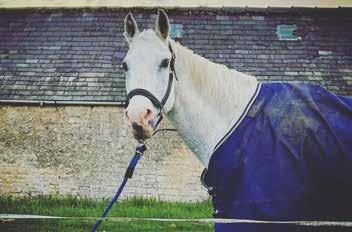
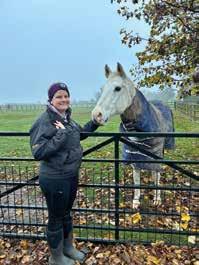
I am AS1 Baker and recently attended the RAF Women’s Rugby League Camp at RAF Cranwell. This was my first ever time attending a women’s sports camp away from RAF Leeming and also my first time playing in any rugby league match.
Irecently started training for rugby league at my home base, RAF Leeming. Here we would train one to two times a week as a mixed male and female group. As a complete beginner to RAF Rugby League, but also the sport itself, I was nervous and apprehensive about attending a training camp for a sport I had never played before! However, attending the training sessions at RAF Leeming enabled me to develop my confidence not only in the sport, but also as an individual. My time training at RAF Leeming went on to provide me with the opportunity to train with the RAF Women’s Rugby League Team, where I have subsequently been able to grow my abilities within rugby, whilst also meeting
a diverse and amazing group of people.
The Women’s Rugby League Camp at RAF Cranwell runs Monday to Friday at the beginning of the season. Players will usually arrive at RAF Cranwell on the Sunday evening before the camp starts, to settle into accommodation and prepare for the first day. On the Monday morning, all players will meet down at the Qaboos where the coach, Cpl Dan Tonkin, will introduce himself to new attendees and a breakdown of the week will be briefed to the girls. Each training day is normally broken down into sections; the day starts with a basic warm up, before spending the rest of the day playing out game scenarios
and learning both simple and more complex rugby skills. During training, the coaches were able to analyse each player throughout, giving pointers and corrections to the team as a whole to help us integrate personal and team skills into our gameplay. As a beginner – this advice helps to find which position you are best suited to play at. For me, I learned that I am best suited as a winger.
After the training days are completed, the team played a competitive game at the end of the week. On the Thursday evening, myself and the other RAF women played against Dewsbury Moore Women’s Team, where I scored my first try at my first ever game. Unfortunately, we were
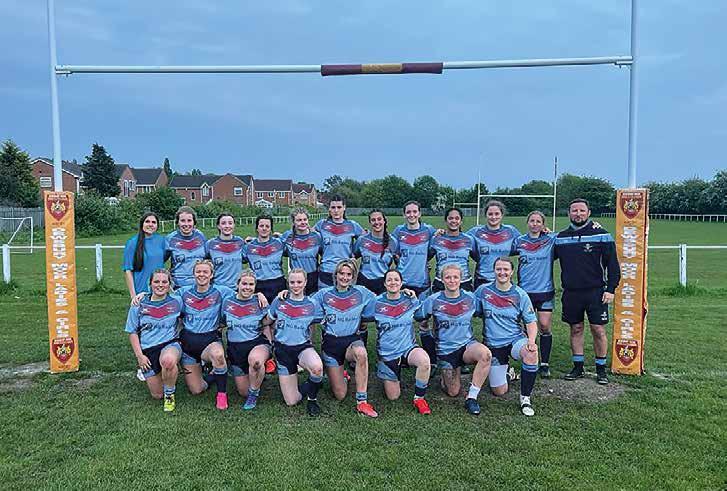
beaten on this occasion, but the week was still an excellent introduction to women’s rugby league within the RAF.
When asked to give his perspective on accessibility to RAF Women’s Rugby League, our Head Coach Cpl Dan Tonkin had the following to say:
“My role within the RAF Women’s Rugby League set up, is to provide enough information for the ladies to be able to compete in the sport, building confidence towards the Interservice Championships. I strongly encourage any standard of player to attend, from novice to rugby league superstar. My task is to build a team spirit within the set-up, with all that attend, getting game time at the end of the week.
The training camp leading up to the game is always run in a way that is enjoyable for all. With the safety aspect of contact rugby, we will aim to build all players up as novices regardless of playing experience. This encourages team ethos and helps work on individual confidence leading to a contact game. Rugby league is a team game, and all are encouraged to give it a try.
Women’s rugby league has grown at a rapid rate the last few years. This is mainly down to the coverage of the last Rugby League World Cup which highlighted the speed, effort and skill of the women’s game. Rugby League has always been the poorer of the two rugby codes in the UK, but with the current drive and increased media coverage, the sport is starting to really “catch up” to the other code.
Regarding RAF Women’s Rugby League, this is also building at a rapid rate. The hope of having an academy within the set up in the next few years, isn’t far away. The station level teams will be the drive behind this happening, with RAF Leeming leading the way.”.
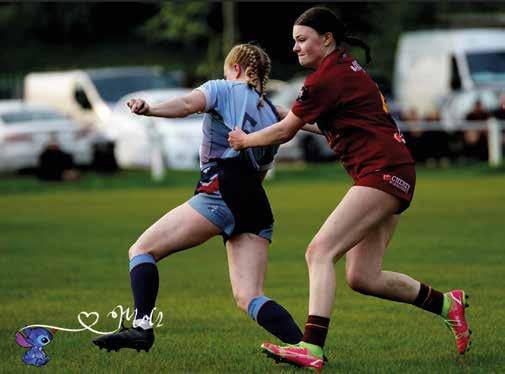
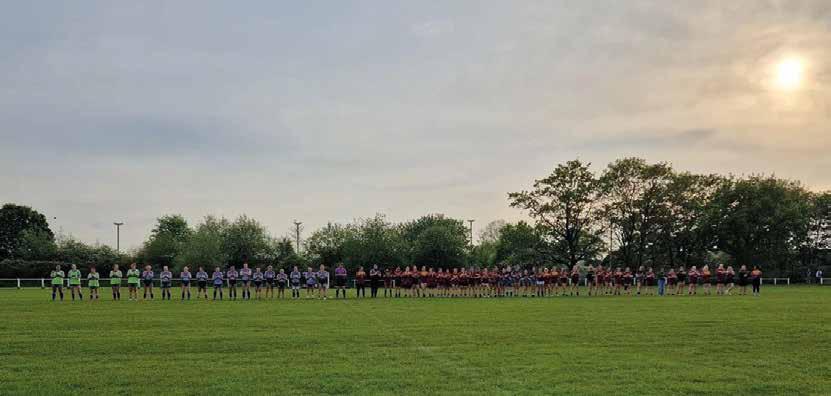
From another player’s perspective, AS1 Grace Houghton-Burnett is one of the most experienced female players within the team. She has given her insight into women’s rugby league:
“As a representative of RAF Women’s Rugby League, I am extremely pleased with the number of opportunities and morale that this sport provides to both myself and my team mates. Rugby league
allows those who compete at all levels, to form a bond between their fellow teammates. Each player must know one another’s limits and pull their weight where necessary meaning mental resilience is key. You are not only participating for yourself, but for those who wear the badge to the left and right of you, and so individual efforts contribute to a greater and more inclusive goal as you strike together, as a unit.
My own experiences and drive have led me to compete at UK Armed Forces level at an early stage of my career, and so this is an example of the opportunities in which participating in rugby league can provide, while playing amongst tri-service personnel and forming partnerships like no other.”
Lastly, as the team’s sports massage therapist, WO Taff Cheedy highlights his role within the team and wider the value of sport within the RAF:
“My role within the squad is to provide medical support during the training sessions and on match day. This support can be wide ranging; anything from providing taping and strapping to the assessment of any injuries, providing advice and treatment. With any injuries to players, I will liaise with the coaching staff to keep them informed to the extent of the injury, and if the player is able to continue. This includes ensuring head injury protocols are followed.”
“ Women’s rugby league has grown at a rapid rate the last few years. This is mainly down to the coverage of the last Rugby League World Cup which highlighted the speed, effort and skill of the women’s game.’’
Once again, it has been a jam-packed few months for Yorkshire Universities Air Squadron (YUAS) here at Leeming, with no plans to let up.
This academic year saw our newest attestees on 54 course complete their induction camp in early March. This training comprised three phases at RAF Cranwell, RAF Leeming and the Lake District. The Cranwell phase consisted of three days of basic ceremonial drill and basic weapon handling on the L85. The Leeming phase taught the Officer Cadets about professional conduct and security whilst on a military base. Finally, the Lake District phase incorporated three days of adventurous training at the NACATC Windermere. This exposed 54 course to the AT opportunities available in the RAF and the benefits associated, including teamwork, leadership and increased mental fortitude.
The Squadron hosted its Annual Formal Dinner on the 24th March at the renowned Solberge Hall, with the Guest of Honour Air Marshall Johnny Stringer, deputy commander of NATO Allied Air Command in Germany. Closely following, YUAS held their Annual Formal Inspection earlier in May, presenting the facilities and personnel to Air Commodore Andrew Dickens, Commandant RAF College Cranwell alongside members of the Military Education Committee. The students had the chance to discuss their training experiences on the Squadron with Air Commodore Dickens.
Overall, these events were a great success and further cemented the Squadron’s reputation with the RAF’s higher chain of command.

Good progress has been made with the Elementary Flying Training (EFT) syllabus. Recently, Acting Pilot Officer Harriet Jones has completed her first Solo and Acting Pilot Officer George Hodgson has completed his solo sector recce sortie, a first since the pandemic for YUAS. Members of 54 course have hit the ground running, with several progressing through the EFT syllabus.
The Squadron recently conducted its annual Easter Camp at RAF Leeming in April. The camp is
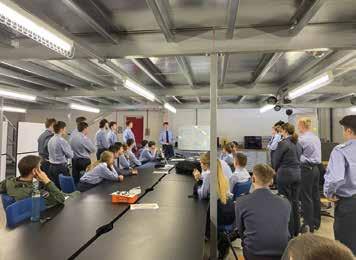
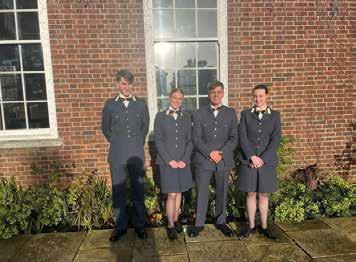

designed to replicate term one of Modularised Initial Officer Training. To implement this, the students delivered briefs individually and as flights to develop public speaking skills. The training provided was diverse, including blues phase around Leeming, greens phase at Adrenalin LTD, and historical military knowledge from visiting the Leeds royal armoury. For many students, this was their first experience of core military skills, such as room inspections and uniform preparation. By working together in their flights and supporting one another, they completed all the tasks, finishing the week with a drill and uniform inspection by the Stn Cdr. Students also benefited from
a brief from the Stn Intelligence Cell, covering some of the UK and NATO’s recent operational deployments.
Following the conclusion of the Easter camp, students seamlessly transitioned into their exam revision period. To prioritise the well-being of our Squadron, student-led coffee meetings have been organised in every city. This has offered students a chance to share and discuss their concerns with fellow peers openly. Students have also maintained strong connections throughout each city by engaging in group runs and study sessions together. Additionally, AT opportunities such as hill walking excursions to the Lake District have been made available. These outings allow students to build up experience towards attaining their own instructor qualifications.
Five members of YUAS attended the annual RAFMA climbing competition, representing both YUAS and RAF Leeming. Unfortunately, the team was defeated by DTUS who scored marginally higher overall, but still took home a victory as Officer Cadet Tom Adam won the novice category. The Squadron was able to promote itself further by attending the 6FTS symposium which involved students competing against other University Air Squadrons.
OC YUAS was presented with an award for his command in the face of various difficulties faced throughout the year.
The Squadron has also made strong efforts to raise money for charity this year. Recently, ten students completed the Leeds Half Marathon, raising an impressive £1259 for the RAF Benevolent Fund. Looking to the future, YUAS will be conducting a 24-hour wheelchair push around the airfield to again raise money for the RAF Benevolent Fund.


Turning our attention to the exciting future ahead, our students are eagerly preparing to provide ground support for the Tutor Display Team at the Cleethorpes Armed Forces Weekend. Additionally, YUAS will be supporting the visit of the Chief of the Air Staff to RAF Leeming on 19th May, hosting lunch with the CAS at the YUAS HQ.
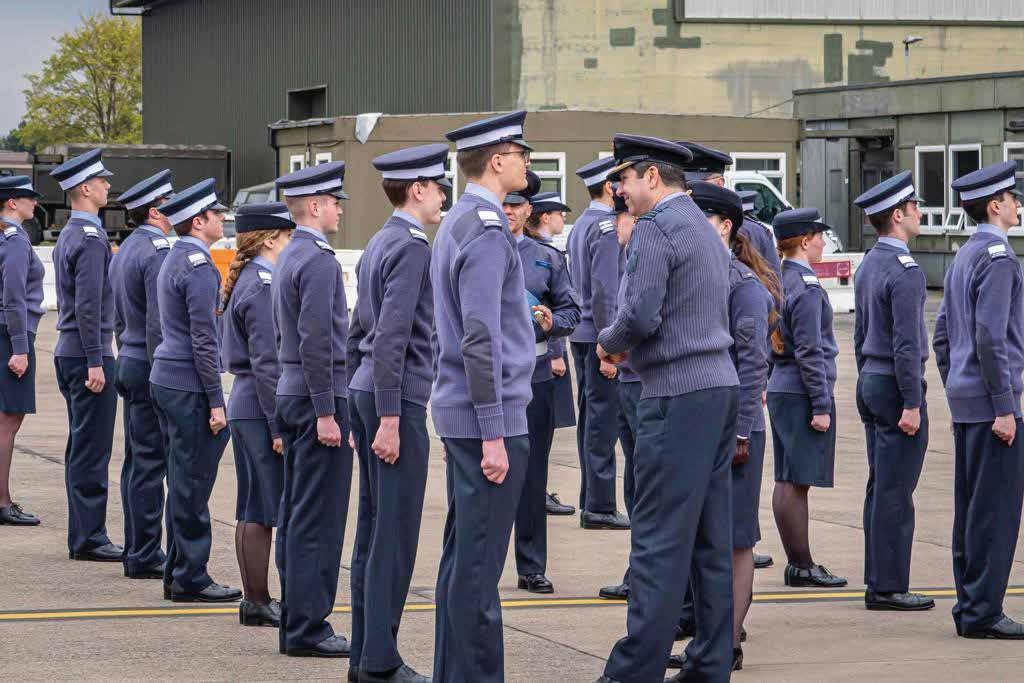
In the spirit of striking a balance between academic commitments and well-deserved
relaxation, our hardworking students will be unleashing the Yorkshire spirit at the upcoming inter-UAS netball competition at RAF Cosford in late May, as well as fully embracing the adventurous training opportunities that lie ahead this summer: including a mountain bike foundation course in the Scottish borders and an Alpine Klettersteig expedition to the Dolomites
The Squadron has also made strong efforts to raise money for charity this year. Recently, ten students completed the Leeds Half Marathon, raising an impressive £1259 for the RAF Benevolent Fund.
As always, the NUAS calendar has been very full. From EFT achievements to JSAT qualifications, and FD trips, students have been busy organising and partaking in activities!
Recently, students on NUAS have been making great progress through the EFT syllabus. All students in this year’s intake have now received their JMES and have begun their flying training. The past few months have also seen some students flying their first solo flight - congratulations to Off Cdts Trevor, Walker, and Varazinskis! Another congratulations to Off Cdt Irwin who flew solo GH! They were honoured to be presented their certificates by Air Commodore Dickens during his visit to the squadron.

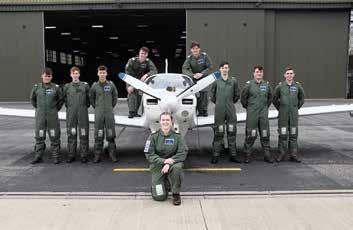


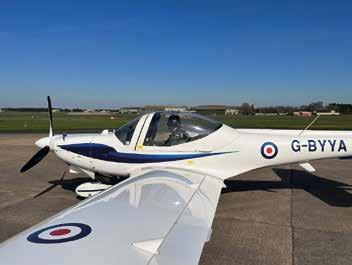
Such progress was facilitated through the flying camps which NUAS held during the Easter holidays. Flying camps are a great opportunity for students to make quick progress through the EFT syllabus, particularly those with busy university timetables who are unable to fly regularly throughout term time.
In March, due to flying cancellations, a group of students took part in a 2-day mid-week AT expedition. This involved mountain biking in Hamsterley Forest and hiking at Malham Cove. The hiking exercise was completely student led, thanks
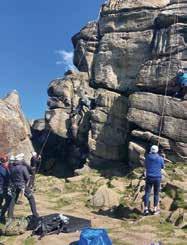
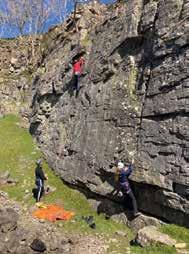


During the Easter Holidays, a group of students took part in Ex Leeming UAS Liberty, which was a week of climbing, led by Flt Lt McMullan and Sgt Todd. At the beginning of the week students prepared and delivered stands on various aspects of climbing to broaden their understanding of the relevant theory. On the first day of climbing, students went to ROF 59 to learn basic climbing practices and skills. The group then used said skills
to one student having the MLT qualification. With more students taking part in AT, many are looking to work their way through the JSAT schemes to facilitate the undergoing of more frequent expeditions, as well as for personal development.
outdoors in the next couple of days at Downholme Quarry to climb limestone and Almscliff Crags to climb gritstone. Due to weather concerns, the last day saw students going back indoors to Harrogate Climbing Centre to hone in on the skills they had developed. By the end of the week, all participants achieved the RSF qualification, and many are planning to continue through the scheme to achieve the RCS qualification.
On 9th May, Air Commodore Dickens visited NUAS to speak to students about their experiences on squadron. Discussions included what students enjoy about squadron life, what they think could be improved in the future, and questions about the wider RAF, with a presentation being delivered by APO Wober and APO Lee.
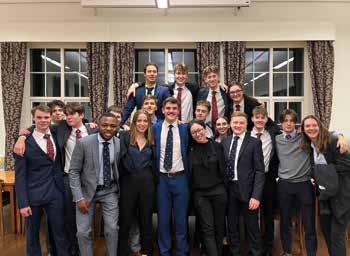


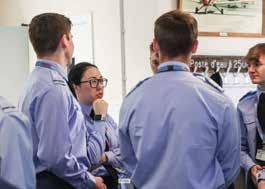
On 23rd April a group of students represented NUAS in the ANZAC parade at Chevington Cemetery in Morpeth. The annual remembrance parade commemorates ANZAC day, which marks the anniversary of
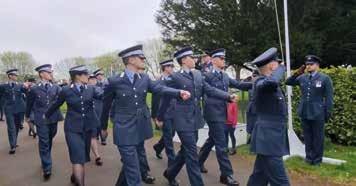
the major military action fought by Australian and New Zealand forces during WWI, remembering the sacrifices made. NUAS were one of two squadrons present, the other being 242 Cramlington Squadron ATC.
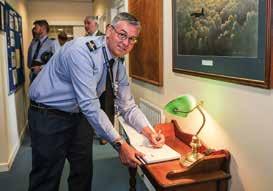
A group of 5 students took part in the 10km Adrenalin Shock Race. Everyone finished the course, with OC Nolan earning a place on the podium in 3rd
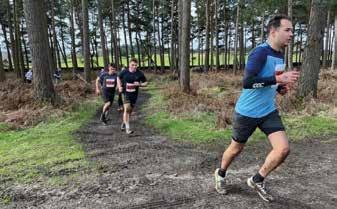
position, finishing in 1 hour. Participants had to tackle around 52 obstacles, involving climbing, crawling, and wading.
As the academic year comes to a close, some students will soon be graduating and leaving NUAS. Some students will be starting IOT in the coming months, whilst others are still in the application process. Not all students decide to join as regulars after they leave university, but all have learnt many important life skills, achieved great personal development, and grown a
stronger appreciation for the RAF, through being part of the squadron. Whilst a week of activities in August will be dedicated to saying goodbye to those leaving, several will not be able to attend due to various commitments, so, at this year’s final Training Night, we bid a farewell to such individuals. We wish everyone the best of luck for the future!
On 17th March, NUAS Annual Dinner was hosted by Leeming Officer’s Mess. Attended by all students and a group of staff, this is always a great occasion where everyone comes together to celebrate achievements from throughout the previous year. The guests of honours this year were AVM Tamara Jennings, Dr John Warren from St Cuthbert’s Society at Durham University, and Brigadier (ret’d) Paul Baker. The awards, as presented by AVM Jennings, consisted of the Airwork Trophy (as won by OC Irwin), Angus Trophy (as won
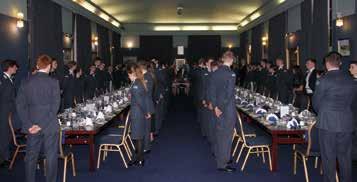

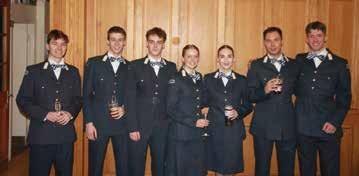
by OC Percy), Ground Training
Trophy (as won by OC Boocock), Sportsperson (as won by OC Berteloot-Chapman), The Toby Mack Trophy (as won by Off Cdt Marshall), Free Northumbrian
Air Force Award (as won by OC Berteloot-Chapman), Ajvir Singh Sandhu Leadership Foundation Trophy (as won by APO Lee), GTI Punchbowl (as won by OC Shadbolt), Ian Bradley Trophy (as won by APO Wober), Boss’ Pot (as won by OC Beeston), Memorable Landing Award (as won by APO Anderson), and The NUAS Trophy (as won by APO Wober).

Between 20th and 24th March, a group of 10 students took part in Ex Brussels Scout in Belgium. The aim of this trip was to understand the role of British forces in conflicts in Belgium throughout the 19th and 20th centuries. Students undertook visits to museums, memorials

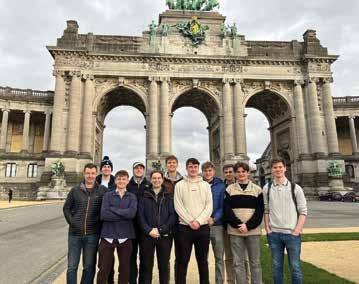
and historic battlefields, to learn about conflicts, including those of Ypres, Bastogne and Waterloo, and gave short presentations on the significance of the location. The group also had the opportunity to visit other sights in Brussels, and visit the Belgian Air Force Spitfire
Memorial Museum. During the summer months, students will be partaking in more FD activities, with visits to locations such as RAF Brize Norton and RAF Akrotiri taking place, as well as a number of students helping at RIAT, and other activities being in the organisation process.

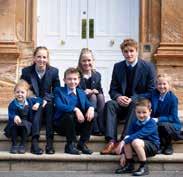





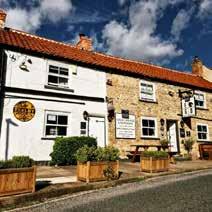

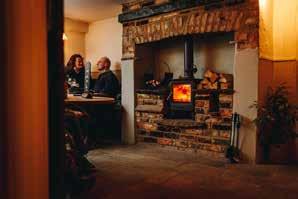

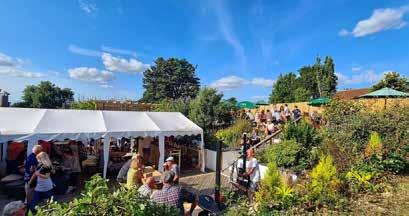












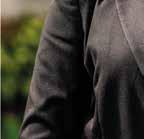





























Queen Ethelburga’s Collegiate is driving forward new and exciting extra-curricular opportunities for its students, as it is the first ever school to participate in the Student Motorsport Challenge, which until now, had seen only universities and colleges compete.

The Student Motorsport Challenge was launched at QE by JP from Student Motorsport alongside a team from Oxford Brookes University, who visited with a kit to prepare the car and coordinated a “Pit Stop Challenge” to demonstrate what is involved in building a race car. From there, Year 12 students and QE staff worked alongside Race Engineer, Will Snuggs from WJS Motorsport Engineering & Trackside, to transform the standard Citroen C1 into a race-ready contender.
Within three weekends, students had already helped strip the car in preparation for fitting new race parts. The car was built in time to compete in the BRSCC Nankang Tyre CityCar Cup Championship at Croft Circuit, where the QE Motorsport Team managed a ground-
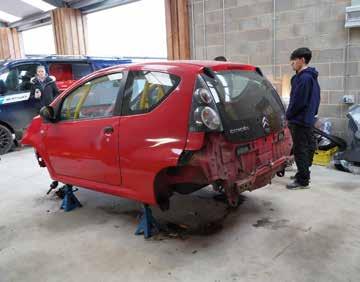
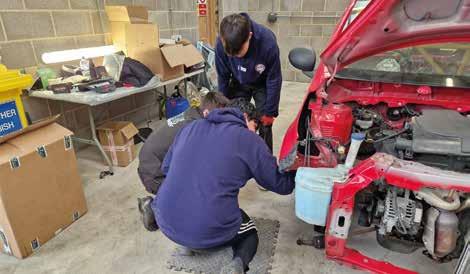
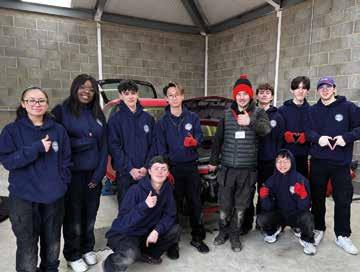
breaking weekend, placing 2nd in Class in the team’s first ever race, and 4th place in both the second and third races. QE Motorsport Team Principal, Helen Snuggs, said that “The enthusiastic student team have worked hard with our driver and have performed amazingly, experiencing everything from building a car to race meeting procedures, live pit wall timings and scrutineering. As the first – and only – school competing, we have broken records never been done before. Our driver, Arthur Simondet, has been so engaging and he consistently won the fastest lap for the SMC (Novice) category in our car. Now, we are looking forward to competing at Anglesey and the other four race weekends.”
Matt Clayton, Head of Co-Curricular at QE, believes that “The Student Motorsport Challenge is a marvellous opportunity for students and has become a fantastic addition to QE’s large co-curricular programme, which is always expanding. I’m thrilled with how the whole team has embraced the experience with a real sense of camaraderie and collaboration and to see a second place in our first ever race of our first ever championship is outstanding.”
To find out more about QE Motorsport, the school, and its co-curricular options, follow @queenethelburgas on Instagram. Or, if you would like to sponsor the Team QE Motorsport Team, please email motorsport@ qe.org.

Within three weekends, students had already helped strip the car in preparation for fitting new race parts.




